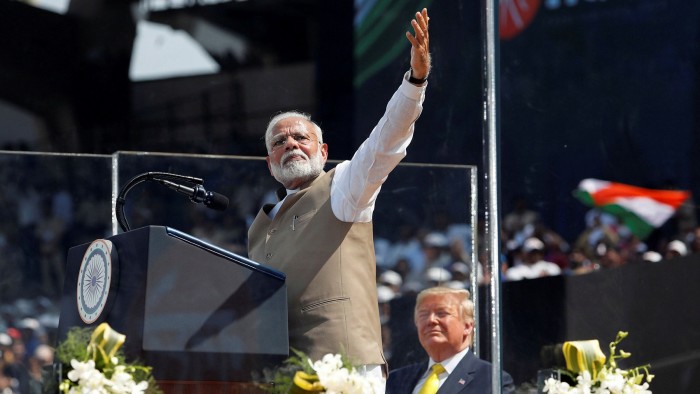Modi forced to tread different path in post-Trump era

Roula Khalaf, Editor of the FT, selects her favourite stories in this weekly newsletter.
When President Donald Trump began a two-day visit to India in February, as many as 100,000 people poured into a cricket stadium in the western city of Ahmedabad for a bombastic rally hosted by Narendra Modi, their local hero.
To thunderous applause, the Indian prime minister heaped praise on his guest of honour. “I present to you my friend, India’s friend . . . Donald Trump,” Mr Modi declared. “Namaste Trump!”
On taking the podium, the US president was similarly effusive: “Everybody loves him,” he told the crowd, referring to Mr Modi.
The jamboree was the high point of a public bromance that Mr Modi had cultivated since Mr Trump was elected in 2016, portraying himself as Washington’s man in Asia and a vital counterweight to an assertive China.
But the election of Joe Biden, followed soon after by the signing of the Regional Comprehensive Economic Partnership — a 15-nation Asian trade deal that India abandoned last year — has left Mr Modi looking more vulnerable.
At the same time that India’s neighbours, including China, are deepening economic ties, Mr Biden is reassessing Washington’s global priorities. New Delhi’s need to strengthen partnerships has seldom been greater, with the country’s economy suffering under the coronavirus crisis and its troops locked in a stand-off on its Himalayan border with China.
“India was one of the few countries that got used to working with Trump,” said Amitendu Palit, a former Indian civil servant and senior research fellow at the Institute of South Asian Studies in Singapore.
Even Mr Modi’s decision to withdraw from RCEP talks exhibited “Trumpian influence”, Mr Palit said, echoing the US president’s 2017 exit from the Trans-Pacific Partnership trade deal. “India was surviving in a world which was developing trade scepticism,” he said. “If the US view on trade changes . . . then India might just find itself in a fairly isolationist space.”
While India remained nonaligned through the cold war, it has in recent decades strengthened ties with the US from defence co-operation to the cultural links forged by the 4m-strong Indian-American community.
New Delhi had also worked at repairing its uneasy relationship with Beijing. The RCEP negotiations, which began in 2012, would have advanced India’s integration in the region by reducing tariffs and other barriers.
But Mr Modi walked away from the deal last November because of fears the country would be flooded by cheap Chinese imports.
Some analysts said the decision was a missed opportunity to expand ties with other signatories such as Australia. Pulling out of RCEP “hampers [India’s] ability to play a greater role in the Asia Pacific”, said Akhil Bery of the Eurasia Group, a consultancy.
But others argued that clashes with China on their shared mountainous border in June, in which at least 20 Indian soldiers died, made RCEP politically impossible, though India can rejoin it.
The stand-off “adds to all the other arguments against a free trade agreement which will include China”, said Gautam Bambawale, who served as India’s ambassador to China until 2018.
Mr Bambawale argued that the RCEP should instead provide a renewed impetus for India to strengthen existing trade deals with other members such as Japan and to forge new ones — including a long-mooted trade package with the US, once Mr Biden has settled into office.
This will prove tricky. Trade was the biggest sticking point between Mr Modi and Mr Trump, who often lashed out at India over its tariffs despite the leaders’ public displays of friendship. The trade package, which seeks to boost US agricultural exports while eliminating tariffs on Indian steel, has not been finalised.
Some observers feel India has taken a more protectionist turn under Mr Modi, who has adopted Atmanirbhar Bharat, or “self-reliant India”, as a slogan. High-profile US businesses such as Amazon have been hit by policy twists.
“Can you honestly tell me that . . . because of all these FTAs today, India is more innovative, India is more competitive, Indian manufacturing is thriving, Indian exports are booming?” Subrahmanyam Jaishankar, India’s foreign minister, asked in September. “They’re not.”
Mr Modi called Mr Biden, the president-elect, last week to congratulate him. During the call, they discussed climate change and Mr Modi expressed pride that Kamala Harris, Mr Biden’s running mate, was the daughter of an Indian immigrant.
But some analysts warn that Mr Biden’s goal of restoring a values-based foreign policy, as opposed to Mr Trump’s more transactional approach, could strain relations with Mr Modi. New Delhi would bristle at international censure of its domestic policy agenda that critics maintain marginalises India’s Muslim minority.
One area where Mr Modi and Mr Biden will find common ground is defence: both countries want to counter China’s growing might. Mike Pompeo, US secretary of state, travelled to India in October to sign a military intelligence-sharing agreement.
“The management of relations with China . . . will be a continuing and crucial priority for both India and the United States, transcending politics and personalities,” said Nirupama Rao, a former Indian ambassador to both the US and China.
With Chinese troops still massed on India’s borders — along with Beijing’s adventurism in the South China Sea — defence imperatives may supersede any other policy disagreements.
Tanvi Madan of the Brookings Institution said geopolitical pragmatism would continue to drive the US-India relationship. “The horse that the US has bet on is India, and the horse that India has bet on is the US.”
Comments